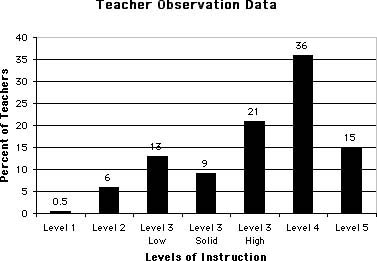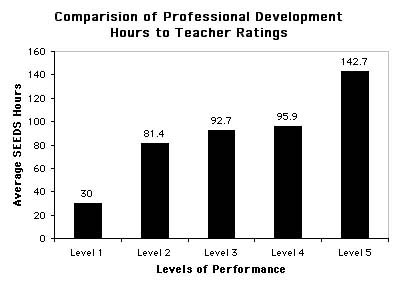 |
|
|
Poster Presentation Full Text: "Honor the Wisdom of the Teacher" Poster presentations are composed in four parts:
|
|
What would sustainability look like:
Our primary goal was to move from a text-based science program to a hands-on, minds-on science program. In 1999-2000, a "Continuous Improvement Team" of seven teacher-leaders spent an entire year evaluating the science programs in our sixteen school districts (1000 teachers and 25,000 students).

We were pleased that 94% of the teachers had moved from a text-based program to a hands-on science program. However, only 51% of teachers doing the "hands-on, minds-on" science with strategies that deepen the students' understanding of science concepts (levels 4 and 5) accomplished the minds-on component.
Components of Hands-On Science Instruction
Components of Minds-On Science Instruction
This is a significant accomplishment in five years. Our goal will become how to sustain this change with new teachers every year well as continue to move more teachers into the higher skill levels of "4" and "5".
A major component of our model was the implementation of a Lead Teacher in each of the sixteen districts. It was a model that was very successful in one of our districts prior to submitting the NSF grant in 1994. The NSF grant provided limited funds for districts to either give release time or stipends or both to have a lead teacher who would:
r goals for the next five years.
( BACK TO POSTER | BACK TO TOP )
"What we call the beginning is often the end. And to make an end is to make a beginning, the end is where we start from." - T.S. Eliot
We began our project in 1992 and feel we have made significant accomplishments, but there are still significant improvements to be made. We are working on our continuous improvement plan for the next five years.
One of the major strengths of our model was the philosophy of "Honor the Wisdom of the Teacher." Alan November, technology guru, once called a "child-centered" approach to learning, "Honoring the Wisdom of the Child." This is the philosophy of learning for our classrooms. We adapted this to develop our philosophy for teacher professional development: "Honor the Wisdom of the Teacher." We believe that teachers are responsible for making their own growth and continual improvement. Teachers need initial training which can be provided by master teachers. But for transfer to take place, they must be allowed time to reflect on the process and its outcomes with other teachers during a year-long process.
Our program was developed by six classroom teachers; three of which are now curriculum directors in our districts and one is a building principal. These teachers trained teacher leadership teams in each district who over-time trained all the other teachers. Teachers served as Lead Teachers and others served on the Continuous Improvement Team which did an in-depth evaluation of each district last year. Putting teachers in the drivers-seat of reform is essential; however, it may not be sufficient for sustainability.
A survey given this year (2000-2001), indicated 13 of the 16 districts continued funding the Lead Teacher position after the grant was completed. We did not continue monthly lead teacher meetings but we are discussing whether we should continue them to assist in sustainability.
There is concern that having a Lead Teacher in each district will NOT be sufficient to maintain sustainability and make continued improvement as well. We have spent a year visiting science material centers across the country and are developing a proposal to our districts and local foundations to possibly develop and implement a center for Stark County. We now feel it is the best way to insure sustainability of a hands-on, minds-on elementary science program.
( BACK TO POSTER | BACK TO TOP )
1. Reduce the number of science units that are used. Eight years ago, we wanted districts to give up buying textbooks, so we felt it was imperative to let them choose their kits to meet the standards and develop their own scope and sequence. With sixteen locally controlled districts, this has made the development of a cost-effective method of training new teachers very difficult. In the next five years, we want to reduce the number of kits available to use so we can more successfully develop a county wide science materials center. This may not be an issue with single district programs.
2. Develop a plan for training new teachers every year. We did not realize we were having 10% of our teachers change every year until Year III. We did not have a plan to train new teachers each year until year IV. There should be some initial immersion training for every new teacher as well as being provided a mentor or coach who teaches the same units. We feel the development of a science materials center will not only guarantee the availability of needed materials, but provide for a mechanism to more adequately train new teachers every year.
3. Quit Aligning and Integrating and Focus on improving Student Achievement. A year-long study component of teachers working collaboratively is essential to making changes and continual improvement. However, we focused too many years on alignment of the curriculum outcomes with instruction and assessment. After that was completed, teachers wanted to integrate science with a variety of other disciplines. This is important as well, but we now feel teachers should be focusing on improving student achievement.....looking at results, looking at student work.......and seeing how they can help students improve. This is another of our major goals for the next five years.
( BACK TO POSTER | BACK TO TOP )
1. With the national and state emphasis on reading currently, what are other districts doing to enhance this without reverting to a text-based program? Are some districts going back to textbook programs?
2. Is a science materials center essential for sustainability of a hands-on, minds-on program?
3. Are their too many skill demands on elementary teachers? Does an exemplary program require that science be departmentalized in the elementary grades and permit teachers to focus on specific areas?
4. Are other districts finding their hands-on science program being hampered by a state-mandated test in science?

THIS POSTER WAS PREPARED BY:
Jane Hazen Dessecker of the Science
Education Enhancing the Development of
Skills (SEEDS) project.
( BACK TO POSTER | BACK TO TOP )
|